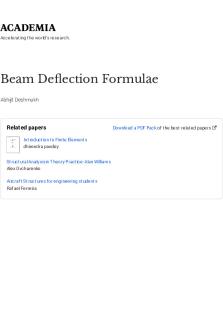Aus AS3600 Deflection Presentation PDF

| Title | Aus AS3600 Deflection Presentation |
|---|---|
| Course | Concrete Design |
| Institution | University of Technology Sydney |
| Pages | 18 |
| File Size | 1.3 MB |
| File Type | |
| Total Downloads | 101 |
| Total Views | 141 |
Summary
Download Aus AS3600 Deflection Presentation PDF
Description
Lecture 7 Serviceability deflections • Deflection limits • Deemed-to-comply conditions, simplified procedure and refined approach • Short and long term effects • Load combinations • Moment of inertia
There are 3 main types of deflection problem that may affect the serviceability of a structure: 1) Where excessive deflection causes either aesthetic or functional problems; 2) Where excessive deflection results in damage to either structural or nonstructural elements 3) Where dynamic effects cause discomfort to occupants. Examples case 1: Unacceptable sagging of slabs and beams. Problem overcome by limiting the magnitude of the final LONG-TERM (or TOTAL) deflection equal to the sum of the short-term (elastic) deflection plus time dependent deflections (caused by sustained load (creep) and shrinkage). Examples case 2: Deflection-induced damage to ceiling or floor finishes, cracking masonry walls and other brittle partitions. The deflection that occurs after the attachment of the nonstructural element in question, i.e. the INCREMENTAL deflection, must be limited. Examples case 3: vertical motion of floor. Very little quantitative info available in codes
Lef = min{Ln + D , L} D L
L
n
The design for serviceability is frequently the primary consideration when determining the cross-sectional dimensions of beams and floor slabs. This is particularly true in the case of slabs that are typically think in relation to their span and are therefore deflection sensitive! AS3600 specifies 3 basic approaches: •Deemed-to-comply conditions based on the span-to-depth ration (clause 8.5.4 for beams and clause 9.3.4 for slabs of AS3600) •Simplified approach based on the calculation of deflections using approximations (clause 8.5.3 for beams and clause 9.3.2 for slabs of AS3600) •Refined approach The simplified approach are simple to use and involve crude approximations of the complex effects of cracking, tension stiffening, concrete creep and shrinkage and load history. They often produce inaccurate of unconservative predictions when applied to lightly reinforced slabs.
The simplified approach Calculated simplified deflections smaller than deflection limits
Deflections must be calculated taking into account short-term mechanical effects (i.e. elastic deflections due to dead and live loads) and time-dependent effects that are function of the load history and temperature. The time-dependent deflections are difficult to calculate and the simplified method offers an easy solution. But, why are time-dependent effects so important and what exactly are they?
Time-dependent effects = creep and shrinkage
Creep deformations are dependent on LOAD and TIME
σ
Time
ε εplastic
εelastic
εelastic Time
Why is shrinkage so problematic?
Extra tensile strength between cracks called
Tension Stiffening
Shrinkage causes the gradual widening of existing cracks and a significant increase in deflections with time
Total deflection=elastic short-term deflection due to dead (G) and live (Q) loads + + long-term deflection due to sustained load (creep) and shrinkage Elastic deflection at mid-span=
CΔ
M L2ef EI
With M=maximum bending moment
With ψs from Table 4.1 of AS1170.0 (usually equal to 0.7)
In the absence of more accurate calculations, the additional long-term deflection of a reinforced beam due to creep and shrinkage may be calculated by multiplying the short-term (elastic) deflection caused by the sustained loads by a multiplier, Kcs, given by
k cs = [2 − 1.2( Asc / Ast ] ≥ 0.8
Clause 8.5.3.2
With ψL from Table 4.1 of AS1170.0 (usually equal to 0.4)
Total deflection
Δ total = Δ s + kcs Δ s .sus Elastic deflection due to dead load and short-term factorised live load
Elastic deflection due to dead load and long-term factorised live load
Clause 8.5.3.2
Moment of Inertia W
Δ=
L
WL3 EI
1 48
Mid-span deflection Δ
W=wL w L
Δ=
5 384
WL3 EI
Simply supported = Statically determined
Mid-span deflection Δ
Continuous beam = Statically undetermined
Ig Icr
Cracking Moment Mcr .......
A
B
1 1 I ef _midspan + Ief _ supportB 2 2
C
D
1 1 1 I ef _midspan + Ief _ supportB + Ief _ supportC 2 4 4
Deemed-to-comply conditions...
Similar Free PDFs

Aus AS3600 Deflection Presentation
- 18 Pages

AS3600 - Australian Standards
- 213 Pages

AS3600-2009-Concrete Structures
- 10 Pages

Slope-deflection method
- 127 Pages

Beam Deflection Formulae
- 3 Pages

Tutorial 09 Beam Deflection
- 1 Pages

Baurecht Schemata aus Lehrbüchern
- 22 Pages

Tutorial on Deflection of Beams
- 5 Pages

Deflection of framework report
- 10 Pages

Deflection of Bending Beams
- 14 Pages

Deflection of beam - assignment
- 23 Pages

Electric Deflection Lab (Ch 5)
- 5 Pages

Deflection of a Cantilever Beam
- 8 Pages

Fälle aus Skript
- 14 Pages

Zusfg Skript aus Forum
- 16 Pages
Popular Institutions
- Tinajero National High School - Annex
- Politeknik Caltex Riau
- Yokohama City University
- SGT University
- University of Al-Qadisiyah
- Divine Word College of Vigan
- Techniek College Rotterdam
- Universidade de Santiago
- Universiti Teknologi MARA Cawangan Johor Kampus Pasir Gudang
- Poltekkes Kemenkes Yogyakarta
- Baguio City National High School
- Colegio san marcos
- preparatoria uno
- Centro de Bachillerato Tecnológico Industrial y de Servicios No. 107
- Dalian Maritime University
- Quang Trung Secondary School
- Colegio Tecnológico en Informática
- Corporación Regional de Educación Superior
- Grupo CEDVA
- Dar Al Uloom University
- Centro de Estudios Preuniversitarios de la Universidad Nacional de Ingeniería
- 上智大学
- Aakash International School, Nuna Majara
- San Felipe Neri Catholic School
- Kang Chiao International School - New Taipei City
- Misamis Occidental National High School
- Institución Educativa Escuela Normal Juan Ladrilleros
- Kolehiyo ng Pantukan
- Batanes State College
- Instituto Continental
- Sekolah Menengah Kejuruan Kesehatan Kaltara (Tarakan)
- Colegio de La Inmaculada Concepcion - Cebu
